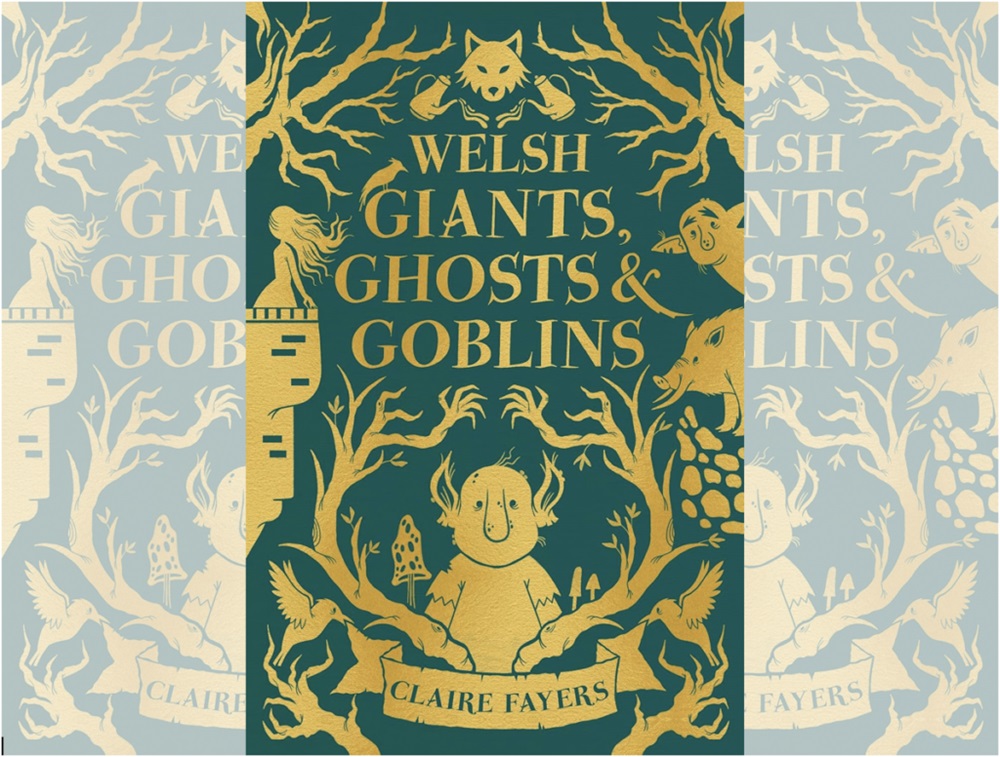Book review: Welsh Giants, Ghosts & Goblins by Claire Fayers

Dan Mitchell
The world of Welsh folk tales is a wild place, populated by a myriad of diverse creatures, powerful magic and sinister apparitions. Its disparate nature can make fitting together these stories of Otherworldy beings, monsters, and Ancient Kings and Queens quite difficult. Even the tales of the Mabinogi, the most revered collection of Welsh folktales, don’t belong together, having been gathered in the 12th century from more ancient sources, only to be named and translated by Lady Charlotte Guest in the 19th century.
It is why it is always exciting to see new collections of folk tales (especially Welsh ones), to find out which of your favourites are included (if any), whether the writer has chosen a specific theme to bring the stories together, and most importantly how the writer has interpreted them.
Alliteration
The title of Claire Fayers’ new collection, Welsh Giants, Ghosts and Goblins gives an idea of how and why these particular tales have been gathered together, and even though other supernatural beings do appear, you can’t beat a well-used bit of alliteration.
As for her interpretation of the work, Fayers sets out her stall in the introduction, explaining that “instead of simply retelling these old tales, I’ve used them as starting points”.
This decision should give all readers something new, whether they are seasoned folk tale fans or newcomers to the genre. Worthy of note is the way Fayers gives a brief introduction to each story, acknowledging the origins of the story and helping to give context.
Curiosity
Our first story is of the Welsh stargazing giant, Idris, and how he set out in the world to search for stories. Idris, the same giant who is believed to be the origin of Cadair Idris (Idris’ Seat), is established in this story as a wise and curious soul. It is this curiosity that has him reappear several times, taking giant strides through the collection and stepping into other people’s stories. This adds a degree of continuity to the book, saving the author from having to establish brand-new characters in such short stories, and Idris becomes a more rounded character than his source material would allow.
The same idea of connecting stories with a familiar character is used in two modernised tales of goblins. In these tales, the writer allows her imagination to take over, and is all the better for it, allowing her to move from the source material whilst keeping the essence. The protagonist, a girl called Bethan, has encounters with the Tylwyth Teg not once but twice and deals with them in a very matter-of-fact manner. This stoicism echoes many traditional folktales, where the protagonists have an encounter, suffer no lasting ill effects, and carry on as normal.
Terrifying
The story of Black Vaughan and his Black Dog is a terrifying ghost story, though its inclusion does make one think about what constitutes a Welsh folktale. It is set in Herefordshire, where Vaughan lived, not in Wales. The real Vaughan worked and lived most of his life in England, in service to the Crown, not in Wales. But the story is a fine one and worthy of its place, even if its Welshness is debatable.
What’s not up for debate, however, is the Welsh language. Names are important in Welsh folktales, and have meaning, so the correct pronunciation can help recreate the world of the story. In the introduction to the stories, there are often helpful guides on how to pronounce the Welsh names within, which is to be commended, as a way of introducing these tales to a non-Welsh speaking audience. However, some of them are wrong, and if you pronounce something wrong in old Welsh, it can easily change its meaning, and therefore the story. While one can argue that Caerffili is pronounced Care-filly by some, the Welsh Ch is never pronounced K.
Oldest
Tackling the hallowed Mabinogi is not a task to be taken lightly. As some of the oldest written stories in Wales, they have a particular status in Welsh culture. That’s not to say that they should be venerated, just that writers should know their sources well before changing them. Fayers’ version of Culhwch and Olwen, debatably one of the first Arthurian tales, treats its source lightly, using the important parts and ignoring the unnecessary ones. This is for the better as the original boasts over 250 characters and would not fit unedited in a book of short stories. The epic tale, here edited into four short parts, contains all the aspects of a great hero’s journey: brave knights, wicked monsters, magic, true love, and a little twist to bring the story up to date.
Welsh Giants, Ghosts & Goblins is an easy, enjoyable read for fans of mythology, and would sit happily on the bedside table of young and old alike. Fayers’ inclusion of details of the source materials in her introductions and author’s note may even encourage readers to dig deeper into the world of Welsh Folktales.
Welsh Giants, Ghosts & Goblins by Clare Fayers is published by Firefly and is available from all good bookshops.
Support our Nation today
For the price of a cup of coffee a month you can help us create an independent, not-for-profit, national news service for the people of Wales, by the people of Wales.




